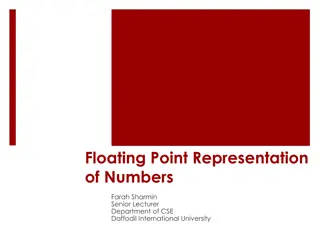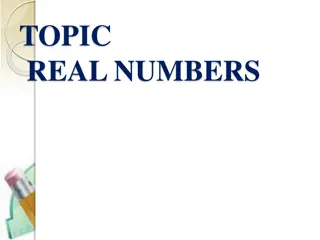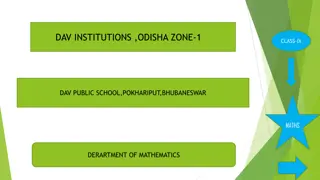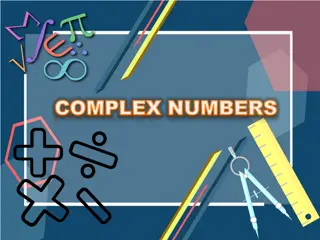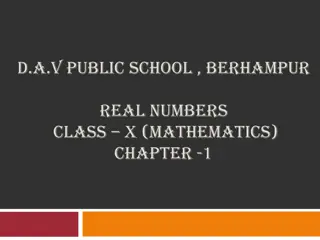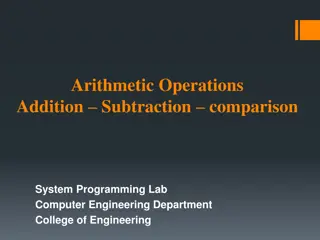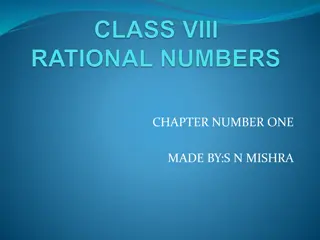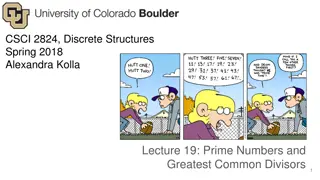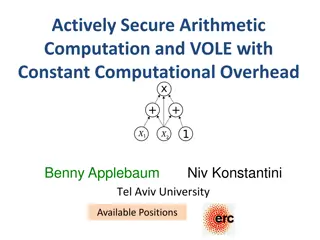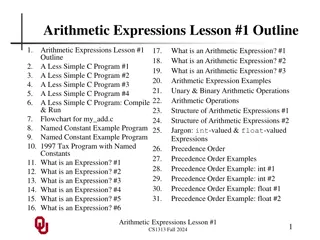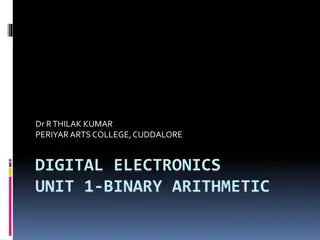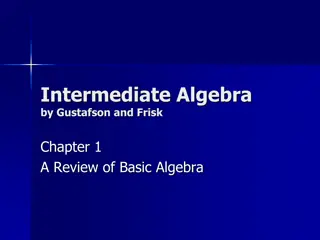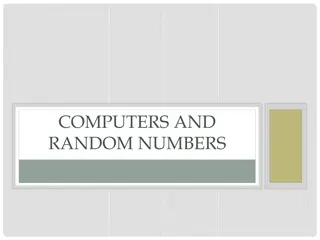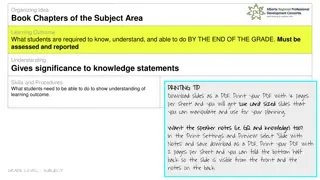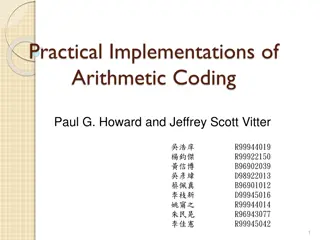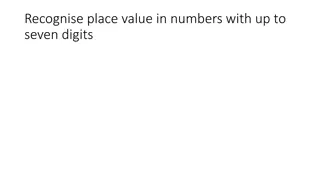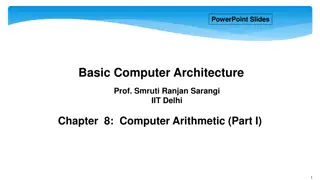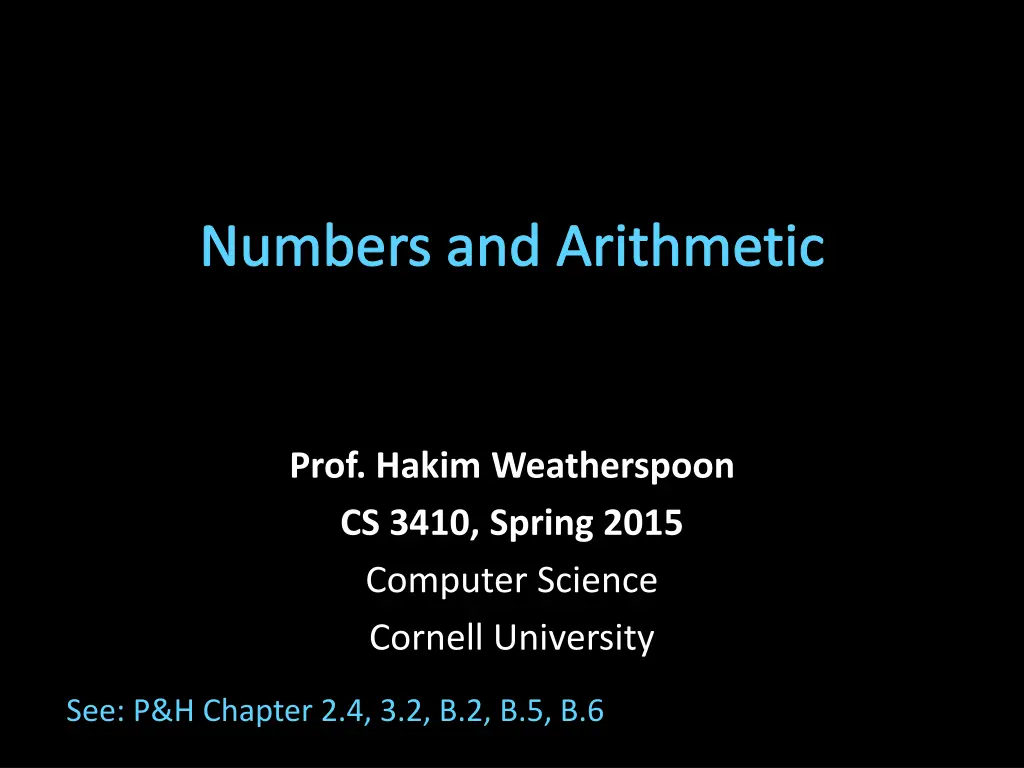
Understanding Number Representations in Computer Science
Explore binary operations, number representations, one-bit, and four-bit adders, and how to deal with negative numbers using two's complement in computer science. Dive into base conversions and counting in different number systems like binary, octal, and hexadecimal.
Download Presentation

Please find below an Image/Link to download the presentation.
The content on the website is provided AS IS for your information and personal use only. It may not be sold, licensed, or shared on other websites without obtaining consent from the author. If you encounter any issues during the download, it is possible that the publisher has removed the file from their server.
You are allowed to download the files provided on this website for personal or commercial use, subject to the condition that they are used lawfully. All files are the property of their respective owners.
The content on the website is provided AS IS for your information and personal use only. It may not be sold, licensed, or shared on other websites without obtaining consent from the author.
E N D
Presentation Transcript
Numbers and Arithmetic Prof. Hakim Weatherspoon CS 3410, Spring 2015 Computer Science Cornell University See: P&H Chapter 2.4, 3.2, B.2, B.5, B.6
Big Picture: Building a Processor inst memory register file alu +4 +4 addr =? PC din dout control cmp offset memory target new pc imm extend A Single cycle processor
Goals for Today Binary Operations Number representations One-bit and four-bit adders Negative numbers and two s compliment Addition (two s compliment) Subtraction (two s compliment)
Number Representations Recall: Binary Two symbols (base 2): true and false; 1 and 0 Basis of Logic Circuits and all digital computers So, how do we represent numbers in Binary (base 2)?
Number Representations Recall: Binary Two symbols (base 2): true and false; 1 and 0 Basis of Logic Circuits and all digital computers So, how do we represent numbers in Binary (base 2)? We know represent numbers in Decimal (base 10). E.g. 6 3 7 102 101 100 Can just as easily use other bases Base 2 Binary Base 8 Octal Base 16 Hexadecimal 1 0 0 1 1 1 1 1 0 1 29 28 27 26 25 24 23 22 21 20 0o 1 1 7 5 83 82 81 80 0x 2 7 d 162161160
Number Representations Recall: Binary Two symbols (base 2): true and false; 1 and 0 Basis of Logic Circuits and all digital computers So, how do we represent numbers in Binary (base 2)? We know represent numbers in Decimal (base 10). 6 102+ 3 101+ 7 100 = 637 E.g. 6 3 7 102 101 100 Can just as easily use other bases Base 2 Binary Base 8 Octal Base 16 Hexadecimal 1 29+1 26+1 25+1 24+1 23+1 22+1 20 = 637 1 83+ 1 82+ 7 81 + 5 80 = 637 2 162 + 7 161 + d 160 = 637 2 162 + 7 161 + 13 160 = 637
Number Representations: Activity #1 Counting How do we count in different bases? Dec (base 10) Bin (base 2) Oct (base 8) Hex (base 16) 0 1 2 3 4 5 6 7 8 9 10 11 12 13 14 15 16 17 18 . . 99 100 0 1 0 1 2 3 4 5 6 7 0 1 2 3 4 5 6 7 8 9 a b c d e 0 1 2 3 4 5 6 7 8 9 a b c d e f f 10 11 100 101 110 111 1000 1001 1010 1011 1100 1101 1110 1111 1 0000 1 0001 1 0010 10 11 12 13 14 15 16 17 20 21 22 10 11 12 . . . . . .
Number Representations How to convert a number between different bases? Base conversion via repetitive division Divide by base, write remainder, move left with quotient lsb (least significant bit) 637 8 = 79 remainder 5 79 8 = 9 remainder 7 9 8 = 1 remainder 1 1 8 = 0 remainder 1 msb (most significant bit) 637 = 0o 1175 msb lsb
Number Representations Convert a base 10 number to a base 2 number Base conversion via repetitive division Divide by base, write remainder, move left with quotient 637 2 = 318 remainder 1 318 2 = 159 remainder 0 159 2 = 79 remainder 1 79 2 = 39 remainder 1 39 2 = 19 remainder 1 19 2 = 9 remainder 1 9 2 = 4 remainder 1 4 2 = 2 remainder 0 2 2 = 1 remainder 0 1 2 = 0 remainder 1 637 = 10 0111 1101 (can also be written as 0b10 0111 1101) lsb msb lsb (least significant bit) msb (most significant bit)
Number Representations Convert a base 10 number to a base 16 number Base conversion via repetitive division Divide by base, write remainder, move left with quotient 637 16 = 39 remainder 13 39 16 = 2 remainder 7 2 16 = 0 remainder 2 lsb dec = hex 10 = 0xa 11 = 0xb 12 = 0xc 13 = 0xd 14 = 0xe 15 = 0xf = bin = 1010 = 1011 = 1100 = 1101 = 1110 = 1111 msb 637 = 0x 2 7 13 = 0x 2 7 d Thus, 637 = 0x27d ?
Number Representations Convert a base 2 number to base 8 (oct) or 16 (hex) Binary to Hexadecimal Convert each nibble (group of four bits) from binary to hex A nibble (four bits) ranges in value from 0 15, which is one hex digit Range: 0000 1111 (binary) => 0x0 0xF (hex) => 0 15 (decimal) E.g. 0b10 0111 1101 0b10 = 0x2 0b0111 = 0x7 0b1101 = 0xd Thus, 637 = 0x27d = 0b10 0111 1101 Binary to Octal Convert each group of three bits from binary to oct Three bits range in value from 0 7, which is one octal digit Range: 0000 1111 (binary) => 0x0 0xF (hex) => 0 15 (decimal) E.g. 0b1 001 111 101 0b1 = 0x1 0b001 = 0x1 0b111 = 0x7 0b101 = 0x5 Thus, 637 = 0o1175 = 0b10 0111 1101
Number Representations Summary We can represent any number in any base Base 10 Decimal 6 3 7 6 102+ 3 101+ 7 100 = 637 102 101 100 Base 2 Binary 1 0 0 1 1 1 1 1 0 1 29 28 27 26 25 24 23 22 21 20 1 29+1 26+1 25+1 24+1 23+1 22+1 20 = 637 Base 8 Octal 0o 1 1 7 5 83 82 81 80 1 83+ 1 82+ 7 81 + 5 80 = 637 Base 16 Hexadecimal 0x 2 7 d 162161160 2 162 + 7 161 + d 160 = 637 2 162 + 7 161 + 13 160 = 637
Takeaway Digital computers are implemented via logic circuits and thus represent all numbers in binary (base 2). We (humans) often write numbers as decimal and hexadecimal for convenience, so need to be able to convert to binary and back (to understand what computer is doing!).
Next Goal Binary Arithmetic: Add and Subtract two binary numbers
Binary Addition How do we do arithmetic in binary? 1 Addition works the same way regardless of base Add the digits in each position Propagate the carry Carry-out 183 + 254 437 Carry-in 1 1 1 Unsigned binary addition is pretty easy Combine two bits at a time Along with a carry 001110 + 011100 1 1 0 0 1 0
Binary Addition How do we do arithmetic in binary? 1 Addition works the same way regardless of base Add the digits in each position Propagate the carry 183 + 254 437 111 Unsigned binary addition is pretty easy Combine two bits at a time Along with a carry 001110 + 011100 101010
Binary Addition Binary addition requires Add of two bits PLUS carry-in Also, carry-out if necessary
1-bit Adder Half Adder Adds two 1-bit numbers Computes 1-bit result and 1-bit carry No carry-in A B Cout S A B Cout S 0 0 0 1 1 0 1 1
1-bit Adder with Carry B Full Adder Adds three 1-bit numbers Computes 1-bit result and 1-bit carry Can be cascaded A Cin Cout S Activity: Truth Table and Sum-of-Product. Logic minimization via Karnaugh Maps and algebraic minimization. Draw Logic Circuits A B Cin 0 Cout S 0 0 0 0 1 0 1 0 0 1 1 1 0 0 1 0 1 1 1 0 1 1 1
4-bit Adder 4-Bit Full Adder Adds two 4-bit numbers and carry in Computes 4-bit result and carry out Can be cascaded A[4] B[4] Cin Cout S[4]
4-bit Adder A3 B3 A2 B2 A1 B1 A0 B0 Cout Cin S3 S2 S1 S0 Adds two 4-bit numbers, along with carry-in Computes 4-bit result and carry out Carry-out = overflow indicates result does not fit in 4 bits
Takeaway Digital computers are implemented via logic circuits and thus represent all numbers in binary (base 2). We (humans) often write numbers as decimal and hexadecimal for convenience, so need to be able to convert to binary and back (to understand what computer is doing!). Adding two 1-bit numbers generalizes to adding two numbers of any size since 1-bit full adders can be cascaded.
Next Goal How do we subtract two binary numbers? Equivalent to adding with a negative number How do we represent negative numbers?
First Attempt: Sign/Magnitude Representation First Attempt: Sign/Magnitude Representation 1 bit for sign (0=positive, 1=negative) N-1 bits for magnitude 0111 = 1111 = 1111 = -7 0111 = 7 Problem? Two zero s: +0 different than -0 Complicated circuits 0000 = +0 1000 = -0 IBM 7090
Second Attempt: Ones complement Second Attempt: One s complement Leading 0 s for positive and 1 s for negative Negative numbers: complement the positive number 0111 = 1000 = 1000 = -7 0111 = 7 Problem? Two zero s still: +0 different than -0 -1 if offset from two s complement Complicated circuits Carry is difficult 0000 = +0 1111 = -0 PDP 1
Twos Complement Representation What is used: Two s Complement Representation Nonnegative numbers are represented as usual 0 = 0000, 1 = 0001, 3 = 0011, 7 = 0111 Leading 1 s for negative numbers To negate any number: complement all the bits (i.e. flip all the bits) then add 1 -1: 1 0001 1110 1111 -3: 3 0011 1100 1101 -7: 7 0111 1000 1001 -8: 8 1000 0111 1000 -0: 0 0000 1111 0000 (this is good, -0 = +0)
Twos Complement Non-negatives (as usual): +0 = 0000 +1 = 0001 +2 = 0010 +3 = 0011 +4 = 0100 +5 = 0101 +6 = 0110 +7 = 0111 +8 = 1000 Negatives (two s complement: flip then add 1): 0 = 1111 1 = 1110 2 = 1101 3 = 1100 4 = 1011 5 = 1010 6 = 1001 7 = 1000 8 = 0111 -0 = 0000 -1 = 1111 -2 = 1110 -3 = 1101 -4 = 1100 -5 = 1011 -6 = 1010 -7 = 1001 -8 = 1000
Twos Complement Non-negatives (as usual): +0 = 0000 +1 = 0001 +2 = 0010 +3 = 0011 +4 = 0100 +5 = 0101 +6 = 0110 +7 = 0111 +8 = 1000 8 = 0111 Negatives (two s complement: flip then add 1): 0 = 1111 1 = 1110 2 = 1101 3 = 1100 4 = 1011 5 = 1010 6 = 1001 7 = 1000 -0 = 0000 -1 = 1111 -2 = 1110 -3 = 1101 -4 = 1100 -5 = 1011 -6 = 1010 -7 = 1001 -8 = 1000
Twos Complement Facts Signed two s complement Negative numbers have leading 1 s zero is unique: +0 = - 0 wraps from largest positive to largest negative N bits can be used to represent unsigned: range 0 2N-1 eg: 8 bits 0 255 signed (two s complement): -(2N-1) (2N-1 - 1) E.g.: 8 bits (1000 000) (0111 1111) -128 127
Sign Extension & Truncation Extending to larger size 1111 = -1 1111 1111 = -1 0111 = 7 0000 0111 = 7 Truncate to smaller size 0000 1111 = 15 BUT, 0000 1111 = 1111 = -1
Twos Complement Addition Addition with two s complement signed numbers Perform addition as usual, regardless of sign (it just works) Examples 1 + -1 = -3 + -1 = -7 + 3 = 7 + (-3) = What is wrong with the following additions? 7 + 1 -7 + -3 -7 + -1
Binary Subtraction Why create a new circuit? Just use addition using two s complement math How?
Binary Subtraction Two s Complement Subtraction Subtraction is simply addition, where one of the operands has been negated Negation is done by inverting all bits and adding one A B = A + (-B) = A + ( B + 1) B3 B2 B1 B0 A3 A2 A1 A0 Cout S3 S2 S1 S0
Binary Subtraction Two s Complement Subtraction Subtraction is simply addition, where one of the operands has been negated Negation is done by inverting all bits and adding one A B = A + (-B) = A + ( B + 1) B3 B2 B1 B0 A3 A2 A1 A0 Cout 1 S3 S2 S1 S0 Q: How do we detect and handle overflows? Q: What if (-B) overflows?
Takeaway Digital computers are implemented via logic circuits and thus represent all numbers in binary (base 2). We (humans) often write numbers as decimal and hexadecimal for convenience, so need to be able to convert to binary and back (to understand what computer is doing!). Adding two 1-bit numbers generalizes to adding two numbers of any size since 1-bit full adders can be cascaded. Using Two s complement number representation simplifies adder Logic circuit design (0 is unique, easy to negate). Subtraction is simply adding, where one operand is negated (two s complement; to negate just flip the bits and add 1). .
Next Goal In general, how do we detect and handle overflow?
Overflow When can overflow occur? adding a negative and a positive? adding two positives? adding two negatives?
Takeaway Digital computers are implemented via logic circuits and thus represent all numbers in binary (base 2). We (humans) often write numbers as decimal and hexadecimal for convenience, so need to be able to convert to binary and back (to understand what computer is doing!). Adding two 1-bit numbers generalizes to adding two numbers of any size since 1-bit full adders can be cascaded. Using Two s complement number representation simplifies adder Logic circuit design (0 is unique, easy to negate). Subtraction is simply adding, where one operand is negated (two s complement; to negate just flip the bits and add 1). Overflow if sign of operands A and B != sign of result S. Can detect overflow by testing Cin != Cout of the most significant bit (msb), which only occurs when previous statement is true.
Administrivia Make sure you are Registered for class, can access CMS Have a Section you can go to. Lab Sections are required. Make up lab sections only 8:40amWed, Thur, or Fri Bring laptop to Labs Have project partner in same Lab Section, if possible HW1 will be out soon out Do problem with lecture Work alone But, use your resources Lab Section, Piazza.com, Office Hours, Homework Help Session, Class notes, book, Sections, CSUGLab
Administrivia Check online syllabus/schedule http://www.cs.cornell.edu/Courses/CS3410/2015sp/schedule.html Slides and Reading for lectures Office Hours Pictures of all TAs Homework and Programming Assignments Dates to keep in Mind Prelims: Tue Mar 3rd and Thur April 30th Lab 1: Due Fri Feb 13th before Winter break Proj2: Due Thur Mar 26th before Spring break Final Project: Due when final would be (not known until Feb 14th) Schedule is subject to change
Summary We can now implement combinational logic circuits Design each block Binary encoded numbers for compactness Decompose large circuit into manageable blocks 1-bit Half Adders, 1-bit Full Adders, n-bit Adders via cascaded 1-bit Full Adders, ... Can implement circuits using NAND or NOR gates Can implement gates using use PMOS and NMOS- transistors And can add and subtract numbers (in two s compliment)! Next time, state and finite state machines

